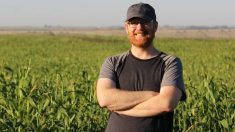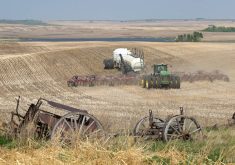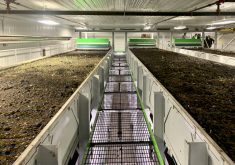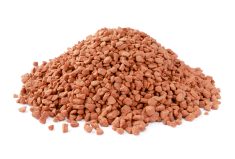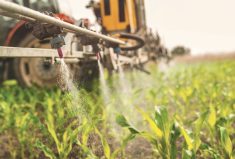Start planning to minimize next year’s risk as soon as you’ve parked the combine — and that starts with fall soil testing, says agronomist Matt Gosling.

“There has probably never been a more critical year in my 18 years of doing agronomy to soil test,” said the owner of Strathmore-based Premium Ag. “Soil testing is probably one of the most affordable things we can do to know exactly what we have in the soil. You can’t manage what you don’t measure.”
The rising cost of fertilizer is an added incentive.
“A year ago we were booking nitrogen for almost 50 per cent less and phosphorus for 30 to 40 per cent less. The higher the cost of nutrition, typically the easier it should be to justify a soil test.”
While some nutrients, notably nitrogen, can be very volatile, and levels can change dramatically between fall and spring, it’s still worthwhile, said Gosling.
Read Also

Farming Smarter receives financial boost from Alberta government for potato research
Farming Smarter near Lethbridge got a boost to its research equipment, thanks to the Alberta government’s increase in funding for research associations.
“It’s really hard for us as professional agronomy providers to make a recommendation on what to book for fertilizer without getting the farm sample,” he said.
His second piece of advice for the coming year is to lower expectations.
“I think one of the easiest ways to mitigate risk going into 2022 — especially without a (soil moisture) recharge between now and seeding — is to address your yield expectations to be a little lower. If we get the right conditions in season there is always a way to top up fertility to address any goal.”
Low expectations weren’t on the menu at the beginning of this year’s growing season. Even though “our soil moisture bank account was low,” Alberta producers “went into this crop with probably the most optimism I have ever seen,” said Gosling.
But attitudes have, understandably, changed.
“A lot of talk on the #AgTwitter circles says this might not be a one-year thing, which I completely agree with,” he said. “We need a drastic recharge to get ourselves back to average territory. I’m not a meteorologist but it certainly feels like it’s going to be dry.
“Things certainly can change and they’re going to have to for me to feel comfortable about being overly aggressive on dryland yield expectations.”
Cutting P possible, but not for long
Gosling predicts one of the biggest questions next spring will be how much phosphorus to put down and he’s expecting many are going to be applying less, partly as a short-term solution to cash flow limitations.
“(Alberta farmers) had a year of P building this spring in which we put down 20 to 40 pounds more per acre of P in our soil piggy bank, so farmers are asking if they can afford to put down less P in 2022,” he said.
“I would assume a lot of the answers to that question are going to be ‘Yes.’”
From a cost point of view, it makes sense. Gosling said he and business partner Andrew Clements were booking P at $680 per tonne last year but the price was around $1,100 in early August.
“Historically if you’ve got good soil test data to support putting down less P, this is going to be the year to do it.”
But again, you need to soil test before taking that step, he said.
“Is it wise to cut back P on a depleted soil and expect a good start to your crop if you’re going to be seeding into cold soil at the beginning of April? That’s a risk I wouldn’t want to take. It’s very difficult to get P down for a crop past seeding.”
However, if there’s enough for next year’s crop, producers could apply phosphorus, potassium and sulphur next fall (if conditions allow) to recharge nutrients “borrowed” from the soil piggy bank.
Although nutrition is always best put in the soil rather than on it, P, K and S applications can be done safely if soil topography, erosion risk, water proximity, incorporation required, residue and soil pH and temperature are conducive, said Gosling.
However, while stabilizers can help, “spreading N on basic soil pH with warm temperatures, lots of residue, hills and minimal incorporation is high risk,” he added.
What to plant and how much
A key decision going into a possibly dry season is size and type of crops.
“Instead of fertilizing for a 50-bushel canola crop, fertilize for a 35-bushel canola crop and if we get the water before the end of June and it looks like we have potential for a 50-bushel-or-more crop, we can fertilize for it in season after planting,” said Gosling.
There’s a reason he uses canola as his go-to crop example: its high price.
Many farmers will still be tempted to plant the water-needy crop next spring even if moisture stores aren’t replenished. But recognize that’s a risky move, he said.
“Commodity prices are another thing that is pretty hard to ignore — if (canola prices are high) it’s going to be hard not to grow canola,” he said.
“So are you going to be pulled by the influence of greed or are you going to be pulled by the influence of agronomy? I think there always has to be an intermingling of the two influences that are built into a good solid rotation.”
On the other hand, crops that cost less to grow and use less water — such as barley, flax and oats — come with risks, too, said Gosling, noting barley, for example, doesn’t do well in extreme heat.
“I don’t know if I’d want to plan on a bunch of barley going into next year even though it’s one of the cheapest crops we can grow.”
Fall and winter crops are also an option but in addition to needing enough moisture to germinate in fall, they need spring moisture.
“Fall crops are very dependent on a wet spring so if we get a wet spring the fall crop will be great. If we don’t, a fall crop might be a disaster.”
It sounds risky and it is, he said.
“But what decision in ag doesn’t come without any amount of risk? I would not plant a fall crop today. If we get two to three inches of precipitation in the next four weeks, would I plant a fall crop? Yes.”
His final piece of advice in regard to soil testing is to hire a pro.
“I can’t stress enough the value of the agronomy profession going into a challenging season,” he said. “I think having somebody on your bench with some agronomic expertise is an invaluable service going into 2022. There’s a great big difference between a soil test and a great soil test.”
Plus self-testing can be extremely taxing.
“I’ve had a farm try to do their own soil testing and it lasted one week. It isn’t fun for them when they’ve been sitting in a combine for weeks or months to go out there and punch a bunch of cores.”




